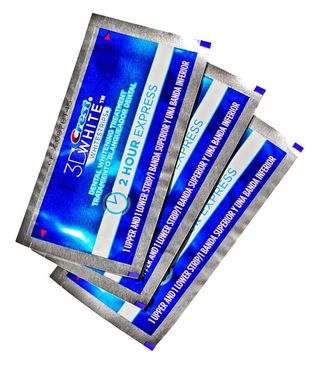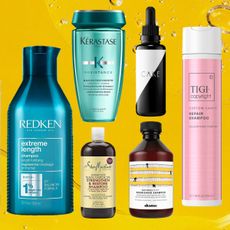

If it's true that the office is a grown-up playground, my career anxieties can be summed up with a quick description of schoolgirl hell. I was the unfortunate kid with an alarming overbite and, to add insult to injury, crooked lower teeth. A boy I worshipped nicknamed me Bugs Bunny; a nemesis called me bucktoothed. I finally persuaded my parents to send me to an orthodontist, who, upon evaluating my mouth in front of several colleagues, declared, "Here we have a young girl who could be pretty if her bite were fixed." I begged my parents for braces, but budgetwise, orthodontics weren't a priority. For years, I fantasized about straight teeth, unbending paper clips and molding them over my incisors when I was alone in my room. Over time, I mastered the fine art of evasion, perfecting a closed-mouthed Mona Lisa smirk.
After college, I'd saved up enough money to achieve my two biggest goals: move to New York and finally get braces. They were awful, wiry things that hurt when they were tightened and pricked my inner cheeks, yet I was still thrilled with them. But my enthusiasm was quickly squashed when, after I landed a coveted job as an editorial assistant, a manager jokingly called me "brace face." Jerky, sure, but the episode exposed an unexpected conundrum: How could I possibly prove myself as a professional if my superiors couldn't see beyond my mouth? Braces made me look younger—hence the juvenile slurs lobbed my way. I considered having them removed but realized that wouldn't solve the bigger issue: My teeth, a major source of insecurity, had become something of a professional liability.
Maybe personal anxieties were getting the best of me. But there's ample evidence to suggest that a gleaming smile is an important factor in evaluating one's career prospects—the dental equivalent of a crisp pantsuit. All other things being equal, job candidates with straight teeth are seen as 45 percent more likely to get hired than those with crooked teeth, according to Kelton Research (which conducted its survey on behalf of the tooth-straightening system Invisalign). And the scrutiny doesn't end once you've landed the job. According to a study by the New York–based think tank Center for Talent Innovation, male and female bosses alike cited stained or crooked teeth (followed by a dated hairstyle and poor complexion) as the single worst appearance blunder undermining a person's "executive presence." As much as performance counts, appearance does subtly affect the way others perceive us.
After suffering for a year, I asked my orthodontist to remove the offensive metal. He advised that I wear the braces another 12 months, but I'd had enough. The big reveal wasn't dramatic, but my overbite was far less acute. Lo and behold, a few months later, my career took off. Armed with newfound confidence, I scored a major promotion that required me to attend more public events—a role that, ironically, required serious smiling.
In the ensuing years, I noticed my teeth inching closer together, my overbite protruding ever so slightly. The mirror betrayed glimpses of my younger self—specifically that smirk I'd perfected so many years ago. It was time for a refresh, only this time around, I had a full-fledged career and simply couldn't afford the stigma of a mouth full of metal.
Fortunately, braces have evolved. For professionals intent on dental discretion, the options are downright thrilling. Take Invisalign, for example, the "invisible" braces first introduced more than a decade ago. Back then, it could take years to achieve results from the custom set of clear plastic aligners that gently nudge teeth straight. But a new "express" version need only be worn for three months or less. At about $5,000, it isn't cheap, but one might argue that a nice smile is as much a part of the professional's arsenal as an impressive wardrobe and a killer elevator pitch.
Instead of adolescents, I largely encountered other BlackBerry-armed suit-and-tie types in the waiting room of my Manhattan orthodontist, Dr. Joseph Hung. "The adults who come to me are busy, and they don't want to look like they're wearing braces," Hung told me. Since the Invisalign trays are computer-generated, he can send patients home with several at once. "That means fewer follow-up appointments," he noted. After all, who has time to duck out of the office every few weeks for a tune-up?
Stay In The Know
Marie Claire email subscribers get intel on fashion and beauty trends, hot-off-the-press celebrity news, and more. Sign up here.
The molds must be worn 22 hours a day—no cheating—and in my case changed every 10 days. Since each new tray conforms to your bite, the straightening is subtle and consistent. Except for some mild tightness in my mouth and the slightly annoying feeling of plastic over my teeth, I barely noticed them, and seemingly, neither did my colleagues.
Recently, I was at a business dinner when an executive at the table excused himself to use the restroom. Just then, I spotted the telltale Invisalign tray case peeking out of his pocket. You have to take out the teeth trays while eating, which has been an unintended godsend for another coworker, who gushed to me that not only had she invested in Invisalign, but that she'd even lost a few pounds while wearing the molds because snacking proved so inconvenient. "They're amazing, right?" she cooed. I had to agree. A month after I'd completed the program, I was promoted yet again. OK, OK, was that really related to my teeth? Whatever. I'm still smiling.
Head to the next page for tips on achieving a winning smile

If you've got overlapping teeth:
Try: OraMetrix SureSmile Braces
Time commitment: Six to 18 months
Cost: About $6,000
Chew on this: Your orthodontist uses a 3-D rendering of your teeth to tailor braces around every nook and cranny. You'll have straighter teeth in one-third of the time it takes traditional braces to work.
If you've got a pronounced overbite:
Try: Lingual Braces
Time commitment: 12 to 36 months
Cost: $5,000 to $9,000
Chew on this: Unlike traditional wire braces, lingual braces adhere to the back of your teeth instead of the front. While you may occasionally cut your tongue on them, your friends and colleagues won't ever see them.
If you've got a gap in your smile:
Try: Veneers
Time commitment: Two to three appointments with a cosmetic dentist
Cost: $1,000 to $1,500 per tooth
Chew on this: If you're not feeling the Lauren Hutton look, your dentist can shave down the teeth on either side of the gap, then bond on veneers to close it up.
Rock a DIY smile with these stellar at-home whitening solutions:
1. Whiteshield Packets, $22 for 50 packs; preventscoffeeteeth.com.
2. Philips Sonicare AirFloss, $100; target.com.
3. AesopMouthwash, $25; aesop.com.
4. Go SmileTriple Action Whitening Light System, $313; gosmile.com.
5. Crest 3D White 2 Hour Express Whitestrips, $55; drugstore.com.
6. Britesmile To Go Whitening Pen, $30; dentamart.com.
7. Colgate Optic White Dual Action Toothpaste, $4; target.com.
Erin Flaherty is a beauty journalist and consultant who has contributed to numerous publications including the Wall Street Journal and Domino, among many others. She is a board member of the Women's Global Empowerment Fund and especially passionate about worldwide beauty anthropology and women's issues. She lives in Woodstock, NY with her husband and dog.
-
 Rihanna Drops a Not-So-Subtle Hint at Her 2024 Met Gala Fashion Plans
Rihanna Drops a Not-So-Subtle Hint at Her 2024 Met Gala Fashion Plans"I'm actually keeping it really simple this year."
By Danielle Campoamor Published
-
 Here's Why Kate Middleton Broke Tradition and Released Prince Louis' Birthday Photo Late
Here's Why Kate Middleton Broke Tradition and Released Prince Louis' Birthday Photo LateIn the past, the Princess of Wales has shared her children's birthday photos right away.
By Danielle Campoamor Published
-
 Kristen Bell Says Husband Dax Shepard Recorded Her "On Laughing Gas"
Kristen Bell Says Husband Dax Shepard Recorded Her "On Laughing Gas""I'd expect nothing less."
By Danielle Campoamor Published
-
 The 32 Best Hair Growth Shampoos of 2024, According to Experts
The 32 Best Hair Growth Shampoos of 2024, According to ExpertsRapunzel hair, coming right up.
By Gabrielle Ulubay Published
-
 The 20 Best Hair Masks for Damaged Hair, According to Experts and Editors
The 20 Best Hair Masks for Damaged Hair, According to Experts and EditorsHealthy strands, here we come!
By Gabrielle Ulubay Last updated
-
 How Often You Should Wash Your Hair, According To Experts
How Often You Should Wash Your Hair, According To ExpertsKeep it fresh, my friends.
By Gabrielle Ulubay Published
-
 The 11 Best Magnetic Lashes of 2023
The 11 Best Magnetic Lashes of 2023Go ahead and kiss your messy lash glue goodbye.
By Hana Hong Published
-
 Beauty Advent Calendars Make the Perfect Holiday Gift
Beauty Advent Calendars Make the Perfect Holiday GiftThe gift that keeps on giving.
By Julia Marzovilla Last updated
-
 The 18 Best Natural Hair Products in 2023
The 18 Best Natural Hair Products in 2023Remember: Your curls are your crown.
By Gabrielle Ulubay Published
-
 The 9 Best Hot Rollers for the Curls of Your Dreams
The 9 Best Hot Rollers for the Curls of Your DreamsThis is how we roll.
By Samantha Holender Published
-
 The 12 Best Cream Eyeshadows, According to Makeup Artists
The 12 Best Cream Eyeshadows, According to Makeup ArtistsThe best part? They’re so easy to apply.
By Samantha Holender Published